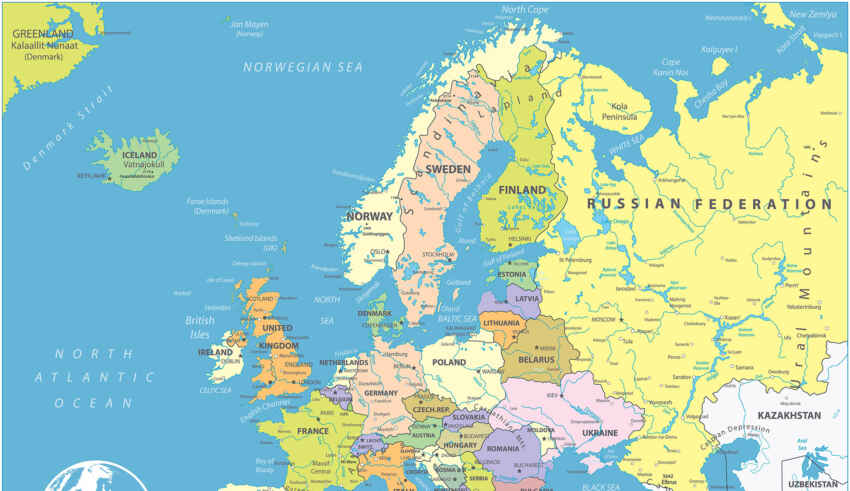
In this context of a new geopolitical and geoeconomic vision that the world is currently experiencing, the ideas that were proposed a few years ago in the EU are being set aside. In this sense, the past strategies leaned towards free trade but with the rise of protectionism, the major economic alliances must reassess and redefine their economic policies. The implementation of an open and integrated pan-European market, based on compatible or harmonized rules and the pursuit of liberalization, should have many positive effects beyond the economic ones, for the Union and its neighbours.
The European Neighbourhood Policy launched in 2004 aims to ‘foster stability, security and prosperity in the EU’s neighbouring regions, both in the South and in the East’ (European External action Service, 2021). Currently, this policy is being reviewed and it is important for the EU to look towards the South. Historically, the focus has been more towards the East with the issue of the reunification of Germany and currently, as expected, with the situation in Ukraine. However, in the South, at the southern border of the EU, there are both great opportunities and threats, such as immigration and jihadist terrorism. More in detail:
The ENP has faced some criticisms and drawbacks, such as:
- Limited impact: Despite the policy’s intentions to support reforms and development in partner countries, its impact has been limited in some cases. Some countries have been reluctant to implement reforms or have faced challenges in doing so.
- Inconsistent implementation: The ENP has been applied unevenly across partner countries, with some receiving more attention and support than others.
- Dependence on EU funding: Some partner countries have become overly dependent on EU funding, which can create an unsustainable situation and limit the effectiveness of the policy.
- Limited involvement of civil society: The ENP has been criticized for not involving civil society and local stakeholders enough in the policy-making process.
- Lack of coordination: There is a lack of coordination between the EU and its member states regarding the ENP, which can result in conflicting priorities and messages being sent to partner countries.
These are areas for improvement to make it a more effective and sustainable policy. It is important also to consider the positive aspects of this policy which include:
- Promoting stability and security: The ENP aims to promote stability and security in the EU’s neighboring regions, which benefits both the EU and its partner countries.
- Supporting economic development: The policy supports economic development in partner countries through trade, investment, and infrastructure projects, which can lead to increased prosperity and job creation.
- Encouraging democratic reforms: The ENP encourages partner countries to implement democratic reforms and improve human rights, which can lead to more stable and accountable governments.
- Enhancing people-to-people contacts: The policy promotes people-to-people contacts through education, cultural exchange, and youth programs, which can foster greater understanding and cooperation between the EU and its partner countries.
- Addressing common challenges: The ENP helps to address common challenges faced by the EU and its partner countries, such as migration, energy security, and climate change, through cooperation and joint initiatives.
Overall, the ENP provides a framework for the EU to engage with its neighboring regions and promote stability, prosperity, and democratic values.
Therefore, for the ENP the concept of redefining the EU’s Southern Neighbourhood policies is essential, but why? Because by developing the North African area, it is possible to bring the production supply chains closer together by rationalizing production in closer EU environments (Morocco, Tunisia, or Turkey among other countries). This ultimately favours shorter logistic chains, reducing the possibility of supply problems as those occurred during the covid, as great part of the materials or products needed during this pandemic were produced in China which posed logistical difficulties due to the world’s lockdown.
The term used to describe the preference for shorter logistic chains is called “nearshoring” as we are living through a time of redefinition of logistics chains, where more and more production is taking place in Morocco and Turkey. Therefore, is time for European ports to take advantage of these developments by creating economic synergies which ultimately will led to the EU’s promotion of stability and prosperity in the region, which can lead to greater security and reduced migration pressures.
References
Akrimi, N. (2005). Política Europea de Vecindad: alcance y límite de una estrategia. Centro de Estudios y de Investigaciones Internacionales y Comunitarias. Retrieved from: https://www.fuhem.es/papeles_articulo/politica-europea-de-vecindad-alcance-y-limite-de-una-estrategia/
European Commission (n.d.). European Neighborhood Policy. Retrieved from: https://commission.europa.eu/strategy-and-policy/policies/european-neighbourhood-policy_en#:~:text=The%20European%20neighbourhood%20policy%20(ENP,political%2C%20economic%20and%20security%20terms.
Lehne, S. (2014). Time to reset the European Neighborhood Policy. Retrieved from: https://carnegieendowment.org/files/time_reset_enp.pdf
European External Action (2021). European Neighborhood Policy. Retrieved from: https://www.eeas.europa.eu/eeas/european-neighbourhood-policy_en#:~:text=The%20ENP%20was%20launched%20in,South%20and%20in%20the%20East.
By The European Institute for International Law and International Relations.













